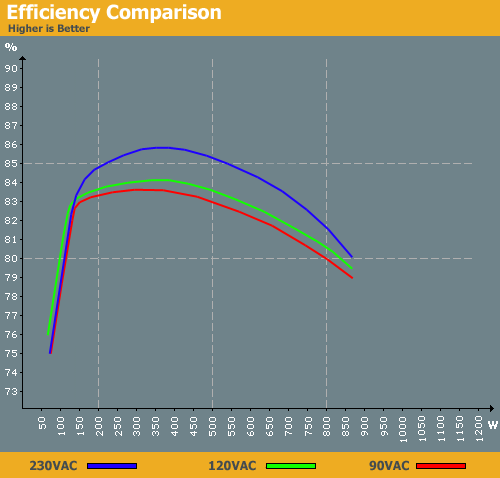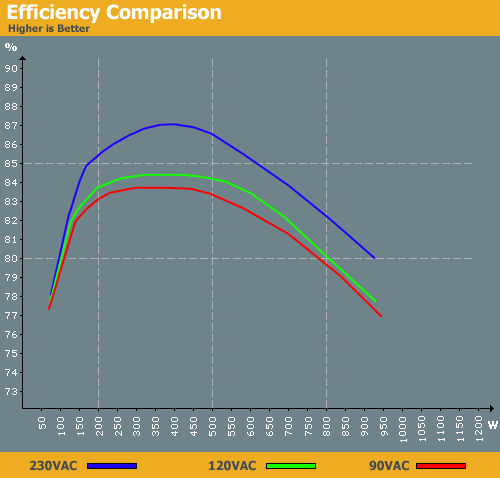OCZ EliteXStream 800W and 1000W
by Christoph Katzer on April 7, 2008 5:00 AM EST- Posted in
- Cases/Cooling/PSUs
Efficiency

We will be bringing two graphics of efficiency from now on. The first shows the efficiency at the load percentages and the second shows the efficiency at the different wattage outputs. The second one gives users a better comparison to other power supplies. If you know the amount of power your system requires, you can look up that load in the table below and see what efficiency the power supplies will provide.


To our surprise, the efficiency is higher than expected. We have seen similar layouts already and the efficiency never exceeded 83% with 230VAC. The 800W EliteXStream reaches its peak efficiency of 86% at a 350W load, and the 1000W version brings it up to 87% at a load of 350-400W. Both are excellent results. Another interesting aspect of performance is that both power supplies provide good efficiency over an amazing range of power loads. In both cases, the efficiency at almost any load a user would apply (at least on a system that would warrant the use of an 800W or 1000W PSU) is more than 80%. It is strange to see that the efficiency is so much higher with 230VAC than lower input voltages; normally the difference is only around 1%.
Acoustics

The EliteXStream runs very quiet at normal room temperatures. The 1000W version is around 5dB(A) louder at higher loads, but at equivalent loads the two units have similar acoustic readings. Only loads of 600W and more begin to cause noticeable noise; before that point, most users will not hear the power supply when it's in a case.
PFC

PFC readings are very good. With lower input voltages, loads from 20% up achieve more than .99 correction. 230VAC also shows good results, even though it's lower than the other two input voltages.










10 Comments
View All Comments
TechnoButt - Thursday, January 1, 2009 - link
I, too, bought this in May/08. Had to RMA within 2 months. Waited the 2 weeks or so to get it replaced (out another $20 for return shipping, of course). Got system built up with it again sometime in August, and here it's dead again. How can they possibly claim such high MTBF when they obviously didn't start testing these units so long ago (they're too new!).What's the point of a 5 year warranty if you have to return ship every 2-3 months to keep your product going?
Don't get me started on my other issues with OCZ from 2008 (Fata1ity memory kits and aggressive SPD programming that don't boot in dell boxes, Vista upgrade memory kits failing, the embarrassment of building corporate demos on the Core SSD drives only to have them corrupt data in front of a customer within 2 weeks of building, having my Vendetta2 hsf suddenly stop cooling my cpu properly (after about 6 weeks of great cooling.. no adjustments.. apparently a thin wall in the center heatpipe/pinprick leak), etc etc etc.
I'm starting to wonder if ocz even has a quality control department anymore, of if they just build for reviews and 'stand behind it' with a long warranty (way behind it.. I mean).
If you haven't already been suckered into buying this PSU by the great reviews here and elsewhere, you'd be better served by finding an older PCP&C unit from before the buyout days. My biggest fear is that PCP&C will succumb to the poor quality culture of their new masters.
StraightPipe - Saturday, December 20, 2008 - link
I took this recommendation and I've had terrible luck.The first PSU ran great, for 2 months. RMA took 2 weeks, and their Customer service would not even acknowledge my request for an advanced replacement.
Second PSU arrives. I'm told it's new, not a refurb. It runs for 5 days and dies. Same thing every time, red light in the back. The forums have a stickie recommending you unplug everything and short the PSU with a paperclip. That doesnt help either.
Now I'm about to buy another PSU while I wait for the OCZ RMA process...
TWO THUMBS DOWN
nubie - Monday, April 7, 2008 - link
I like it, the power output is re-freaking-diculous, you could run a pair of overclocked Dual-Core SLi systems from either of these!!The thing that most interests me is that huge area at the top of the curve in the efficiency charts, if only they will release a 400-600w model that would put that flat spot right where the majority of systems run, IE 150-300 watts.
Another thing of interest to me that I have been noticing lately in your (excellent) reviews, is that 230v is much more efficient. Since I live in the US, would it make sense to have a 230v outlet for my PC? The trade-off in terms of efficiency looks like it would be worth it.
Another thought is that these extreme power supplies that can theoretically draw more than a common 120v circuit breaker can deliver may be better off on their own 230v line. So if you are building or remodeling your house, or just running another power line to your PC, should you consider 220v? (obviously you should use a brightly colored cord for the 220v, and the proper receptacle for the wall outlet.)
vajm1234 - Monday, April 7, 2008 - link
do we really need that much power i have 1 corsair 620 and its enough i think....nubie - Monday, April 7, 2008 - link
Not me, I am still wondering whether this PCPower Silencer 470 is too much(26A on the 12v) for my single card overclocked 7900/Celeron 430 (650mhz, 3.17Ghz P5N-E SLi), but I realized that I might as well have it for when I choose to run more, or put a fan on my HR-05 chipset cooler and run for 4Ghz (It has booted stable at 3.6+, but then heat caused lockups after I got in the OS).See this testimonial http://www.clubit.com/product_detail.cfm?itemno=A6...">http://www.clubit.com/product_detail.cfm?itemno=A6... :
"I have an overclocked quad core, two overclocked 8800's, 3 HDDs, 8 big fans, and an X-Fi card and it's been totally stable."
The user above me is right though, with a Lian-Li v2000 and 12 HDD, overclocked Tri/Quad SLi setup, and/or a 12v refrigerant (phase change) compressor you would be glad for one of these PSU's.
Sunrise089 - Monday, April 7, 2008 - link
600 watt is great for most of us sure...but a few people do have SLI or Tri-SLI setups (or Crossfire) AND overclocked quad-cores. For those folks...I suppose 650w or so might be cutting it too close?petalsofpain - Monday, April 7, 2008 - link
Even though I am more of a biology person... I have been taught that the reason for the voltage being higher in the case of powerlines into orders of magnitude above that of what he have in household appliances has to do with the general fact that the higher the voltage the lower the conduction losses and also 'the less leakage'!So if it really is that way it stands to reason that would we be able to keep the voltages higher that we would be able to have less in the way of losses. You could try the idea out pretty easily but I think that you know the theory behind this... as I have forgotten XD! Fun stuff though. Have a comparison with some server ones that have an efficiency rating maxim of 93% for comparison or even direct explanations. I don!t remember the name of the model or whatever just know that it was here that I read about this model...
Excellent article as usual as Anandtech stands and remains one of the few and amongst the best hardware and software or even general tech sites period!
Let it be known... I AM AN ANANDTECH FANBOY! :)
... something to have those annoying vidia and amd and intel fanboyz be afraid of in the near future ...
homerdog - Monday, April 7, 2008 - link
The second graph on page 8 shows the 800W PSU to be more efficient with 90VAC than with 120VAC. Are the colors mixed up or is this really the case?Christoph Katzer - Monday, April 7, 2008 - link
Damn, yes right. I will fix it, thanks.piroroadkill - Tuesday, April 8, 2008 - link
Also, there's no colour legend on the PFC graph, for the record